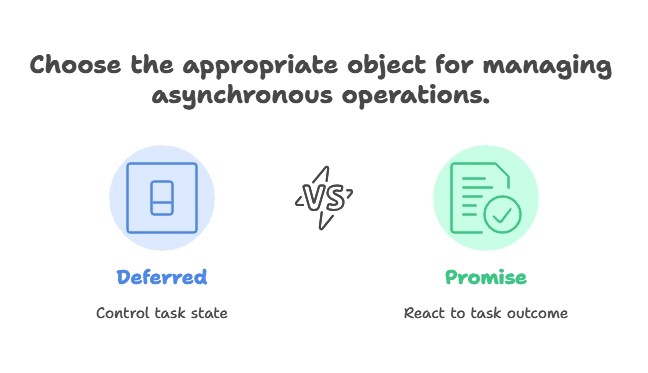Using Deferreds and Promise Objects in jQuery
In jQuery, a Deferred object is a tool designed to manage asynchronous operations. It represents a task that is not yet complete but will be in the future. It allows you to set up callbacks that will be executed when the task completes, either successfully or with an error.
What is a Promise Object?
A Promise object is a simpler, read-only version of a Deferred object. It represents the eventual completion (or failure) of an asynchronous operation and its resulting value. While Deferreds are used to control the state of the task, Promises are used to react to its outcome.

Creating Deferreds and Promises
Creating a Deferred Object
You create a Deferred object using the $.Deferred() function:
var deferred = $.Deferred();
This deferred object can be used to handle asynchronous tasks and manage their states.
Creating a Promise Object
You can obtain a Promise object from a Deferred object by calling .promise():
var promise = deferred.promise();
This promise object can be used to register callbacks and handle the results of the asynchronous operation.
Basic Operations with Deferreds
Defining Callbacks
Deferred objects provide methods to define callbacks for various outcomes:
deferred.done(function(result) {
console.log("Success: " + result);
}).fail(function(error) {
console.log("Error: " + error);
}).progress(function(progress) {
console.log("Progress: " + progress);
});
Explanation:
.done(): Registers a callback for when the Deferred is resolved successfully..fail(): Registers a callback for when the Deferred is rejected with an error..progress(): Registers a callback to handle progress updates.
Resolving and Rejecting
You can manually resolve or reject a Deferred object:
deferred.resolve("Operation completed!");
// or
deferred.reject("Operation failed!");
Output:
- If resolved: “Success: Operation completed!”
- If rejected: “Error: Operation failed!”
Using Deferreds with Asynchronous Tasks
Simulating an Asynchronous Task
Here’s how to simulate an asynchronous operation using setTimeout:
function asyncTask() {
var deferred = $.Deferred();
setTimeout(function() {
deferred.resolve("Task completed successfully!");
}, 2000);
return deferred.promise();
}
asyncTask().done(function(result) {
console.log(result);
});
Explanation:
asyncTask()returns a Deferred object wrapped in a Promise.setTimeoutsimulates an asynchronous task that resolves after 2 seconds..done()logs the result when the Deferred is resolved.
Task completed successfully!
Advanced Concepts with Deferreds and Promises
Chaining Deferreds
Deferreds can be chained to handle sequences of asynchronous operations:
function firstTask() {
var deferred = $.Deferred();
setTimeout(function() {
deferred.resolve("First task completed");
}, 1000);
return deferred.promise();
}
function secondTask() {
var deferred = $.Deferred();
setTimeout(function() {
deferred.resolve("Second task completed");
}, 500);
return deferred.promise();
}
firstTask().done(function(result) {
console.log(result);
return secondTask();
}).done(function(result) {
console.log(result);
});
Explanation:
firstTask()andsecondTask()return Deferred objects.- Chaining
.done()ensuressecondTask()runs only afterfirstTask()completes.
Output:
First task completed
Second task completed
Handling Errors in Chains
To handle errors in a chain of Deferreds:
function failingTask() {
var deferred = $.Deferred();
setTimeout(function() {
deferred.reject("An error occurred!");
}, 1000);
return deferred.promise();
}
failingTask().done(function(result) {
console.log(result);
}).fail(function(error) {
console.log(error);
});
Explanation:
failingTask()simulates a task that fails..fail()handles the error scenario.
An error occurred!
Common Use Cases
AJAX Requests
Deferreds are often used with AJAX requests to handle asynchronous data fetching:
$.ajax({
url: "https://api.example.com/data",
method: "GET"
}).done(function(data) {
console.log("Data received: " + JSON.stringify(data));
}).fail(function(jqXHR, textStatus, errorThrown) {
console.log("Request failed: " + textStatus);
});
Explanation:
- The
.done()method processes the successful response. - The
.fail()method handles any errors.
Output:
- If successful: “Data received: { … }”
- If failed: “Request failed: …”
Custom Deferreds
You can create and manage your own Deferred objects for various custom asynchronous tasks:
function customDeferredTask() {
var deferred = $.Deferred();
// Simulating an asynchronous task
setTimeout(function() {
deferred.resolve("Custom task complete");
}, 3000);
return deferred.promise();
}
customDeferredTask().done(function(message) {
console.log(message);
});
Explanation:
customDeferredTask()simulates a task with a 3-second delay..done()logs the completion message.
Output:
Custom task complete
Deferreds and Promises in jQuery provide powerful abstractions for managing asynchronous operations. By understanding how to create, use, and chain Deferreds and Promises, you can handle complex asynchronous workflows with ease.From basic creation and callback definitions to advanced chaining, error handling, and managing multiple tasks, this chapter covers a broad range of topics. By mastering these concepts, you can write more efficient and readable code for asynchronous tasks in your jQuery applications. Happy coding !❤️
Table of Contents

